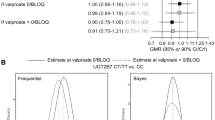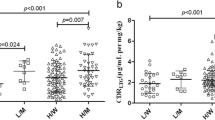Abstract
Purpose
The aim of this study was to investigate the genetic polymorphisms of UGT1A3, UGT1A6, and UGT2B7 in Chinese epilepsy patients and their potential influence on the pharmacokinetics of valproic acid (VPA).
Methods
The genetic architectures of UGT1A3, UGT1A6, and UGT2B7 in 242 epilepsy patients were detected by DNA sequencing and PCR-restriction fragment length polymorphism. Steady-state plasma concentrations of VPA in 225 patients who had received VPA (approx. 250–1,000 mg/day) for at least 2 weeks were determined and associated with UGT polymorphisms.
Results
The allelic distribution of UGT1A3 in our Chinese epilepsy patients was significantly different from that in healthy subjects based on reference data. The standardized trough plasma concentration (CS) of VPA was much lower in our patients with the UGT1A3*5 variant than in the wild type carriers (3.24 ± 1.05 vs. 4.68 ± 1.24 μg·kg·mL-1·mg-1, P < 0.01). UGT polymorphisms had no influence on the pharmacokinetic interactions between carbamazepine and VPA.
Conclusion
Our results suggest that UGT1A3*5 may be an important determinant of individual variability in the pharmacokinetics of VPA and that it may be necessary to increase VPA dose for UGT1A3*5 carriers to ensure its therapeutic range of 50–100 μg/mL.
Similar content being viewed by others
References
Rogawski MA, Loscher W (2004) The neurobiology of antiepileptic drugs for the treatment of nonepileptic conditions. Nat Med 10:685–692
Kuendgen A, Gattermann N (2007) Valproic acid for the treatment of myeloid malignancies. Cancer 110:943–954
Patsalos PN, Perucca E (2003) Clinically important drug interactions in epilepsy: interactions between antiepileptic drugs and other drugs. Lancet Neurol 2:473–481
Nakajima Y, Mizobuchi M, Nakamura M et al (2004) Mechanism of the drug interaction between valproic acid and carbapenem antibiotics in monkeys and rats. Drug Metab Dispos 32:1383–1391
Perucca E (2006) Clinically relevant drug interactions with antiepileptic drugs. Br J Clin Pharmacol 61:246–255
Chung JY, Cho JY, Yu KS et al (2008) Pharmacokinetic and pharmacodynamic interaction of lorazepam and valproic acid in relation to UGT2B7 genetic polymorphism in healthy subjects. Clin Pharmacol Ther 83:595–600
Anderson GD (1998) A mechanistic approach to antiepileptic drug interactions. Ann Pharmacother 32:554–563
Zaccara G, Messori A, Moroni F (1988) Clinical pharmacokinetics of valproic acid—1988. Clin Pharmacokinet 15:367–389
Reith DM, Andrews J, Parker-Scott S et al (2000) Urinary excretion of valproate metabolites in children and adolescents. Biopharm Drug Dispos 21:327–330
Dickinson RG, Hooper WD, Dunstan PR et al (1989) Urinary excretion of valproate and some metabolites in chronically treated patients. Ther Drug Monit 11:127–133
Argikar UA, Remmel RP (2009) Effect of aging on glucuronidation of valproic acid in human liver microsomes and the role of UDP-glucuronosyltransferase UGT1A4, UGT1A8, and UGT1A10. Drug Metab Dispos 37:229–236
Burchell B, Brierley CH, Monaghan G et al (1998) The structure and function of the UDP-glucuronosyltransferase gene family. Adv Pharmacol 42:335–338
Mackenzie PI, Owens IS, Burchell B et al (1997) The UDP-glycosyltransferase gene superfamily: recommended nomenclature update based on evolutionary divergence. Pharmacogenetics 7:255–269
Ethell BT, Anderson GD, Burchell B (2003) The effect of valproic acid on drug and steroid glucuronidation by expressed human UDP-glucuronosyltransferases. Biochem Pharmacol 65:1441–1449
Green MD, King CD, Mojarrabi B et al (1998) Glucuronidation of amines and other xenobiotics catalyzed by expressed human UDP-glucuronosyltransferase 1A3. Drug Metab Dispos 26:507–512
Krishnaswamy S, Hao Q, Al-Rohaimi A et al (2005) UDP glucuronosyltransferase (UGT) 1A6 pharmacogenetics: II. Functional impact of the three most common nonsynonymous UGT1A6 polymorphisms (S7A, T181A, and R184S). J Pharmacol Exp Ther 313:1340–1346
Caillier B, Lepine J, Tojcic J et al (2007) A pharmacogenomics study of the human estrogen glucuronosyltransferase UGT1A3. Pharmacogenet Genomics 17:481–495
Chen Y, Chen S, Li X et al (2006) Genetic variants of human UGT1A3: functional characterization and frequency distribution in a Chinese Han population. Drug Metab Dispos 34:1462–1467
Riedmaier S, Klein K, Hofmann U et al (2010) UDP-glucuronosyltransferase (UGT) polymorphisms affect atorvastatin lactonization in vitro and in vivo. Clin Pharmacol Ther 87:65–73
Kodama Y, Koike Y, Kimoto H et al (1992) Binding parameters of valproic acid to serum protein in healthy adults at steady state. Ther Drug Monit 14:55–60
Kagaya H, Inoue K, Miura M et al (2007) Influence of UGT1A8 and UGT2B7 genetic polymorphisms on mycophenolic acid pharmacokinetics in Japanese renal transplant recipients. Eur J Clin Pharmacol 63:279–288
Iwuchukwu OF, Ajetunmobi J, Ung D et al (2009) Characterizing the effects of common UDP glucuronosyltransferase (UGT) 1A6 and UGT1A1 polymorphisms on cis- and trans-resveratrol glucuronidation. Drug Metab Dispos 37:1726–1732
Tan L, Yu JT, Sun YP et al (2010) The influence of cytochrome oxidase CYP2A6, CYP2B6, and CYP2C9 polymorphisms on the plasma concentrations of valproic acid in epileptic patients. Clin Neurol Neurosurg 112:320–323
Iwai M, Maruo Y, Ito M et al (2004) Six novel UDP-glucuronosyltransferase (UGT1A3) polymorphisms with varying activity. J Hum Genet 49:123–128
Ehmer U, Vogel A, Schutte JK et al (2004) Variation of hepatic glucuronidation: novel functional polymorphisms of the UDP-glucuronosyltransferase UGT1A4. Hepatology 39:970–977
Xing Y, Yang L, Wang L et al (2009) Systematic screening for polymorphisms within the UGT1A6 gene in three Chinese populations and function prediction through structural modeling. Pharmacogenomics 10:741–752
Saeki M, Saito Y, Jinno H et al (2005) Genetic polymorphisms of UGT1A6 in a Japanese population. Drug Metab Pharmacokinet 20:85–90
Lampe JW, Bigler J, Horner NK et al (1999) UDP-glucuronosyltransferase (UGT1A1*28 and UGT1A6*2) polymorphisms in Caucasians and Asians: relationships to serum bilirubin concentrations. Pharmacogenetics 9:341–349
Menard V, Girard H, Harvey M et al (2009) Analysis of inherited genetic variations at the UGT1 locus in the French-Canadian population. Hum Mutat 30:677–687
Lin GF, Guo WC, Chen JG et al (2005) An association of UDP-glucuronosyltransferase 2B7 C802T (His268Tyr) polymorphism with bladder cancer in benzidine-exposed workers in China. Toxicol Sci 85:502–506
Saeki M, Saito Y, Jinno H et al (2006) Haplotype structures of the UGT1A gene complex in a Japanese population. Pharmacogenomics J 6:63–75
Kohle C, Mohrle B, Munzel PA et al (2003) Frequent co-occurrence of the TATA box mutation associated with Gilbert's syndrome (UGT1A1*28) with other polymorphisms of the UDP-glucuronosyltransferase-1 locus (UGT1A6*2 and UGT1A7*3) in Caucasians and Egyptians. Biochem Pharmacol 65:1521–1527
Maruo Y, Iwai M, Mori A et al (2005) Polymorphism of UDP-glucuronosyltransferase and drug metabolism. Curr Drug Metab 6:91–99
Burchell B (2003) Genetic variation of human UDP-glucuronosyltransferase: implications in disease and drug glucuronidation. Am J Pharmacogenomics 3:37–52
Kwara A, Lartey M, Boamah I et al (2009) Interindividual variability in pharmacokinetics of generic nucleoside reverse transcriptase inhibitors in TB/HIV-coinfected Ghanaian patients: UGT2B7*1c is associated with faster zidovudine clearance and glucuronidation. J Clin Pharmacol 49:1079–1090
Gutierrez K, Walter H, Bankier B (1999) Valproic acid and Carbamazepine: a successful antipsychotic medication? The problem of diagnosis and its relevance for therapy. Psychopathology 32:235–241
Chung JY, Cho JY, Yu KS et al (2005) Effect of the UGT2B15 genotype on the pharmacokinetics, pharmacodynamics, and drug interactions of intravenous lorazepam in healthy volunteers. Clin Pharmacol Ther 77:486–494
Kiang TK, Ensom MH, Chang TK (2005) UDP-glucuronosyltransferases and clinical drug–drug interactions. Pharmacol Ther 106:97–132
Funding
This work was supported by the National Natural Science Foundation (Grants 91029746, 81072695), Jiangshu province Natural Science Foundation (Grant BK 2010066), and a funding for innovative research team in institutions of Jiangsu higher education.
Author information
Authors and Affiliations
Corresponding author
Additional information
Xiao-Man Chu and Li-Fang Zhang contributed equally to this work.
Electronic supplementary material
Below is the link to the electronic supplementary material.
ESM 1
(DOC 113 kb)
Rights and permissions
About this article
Cite this article
Chu, XM., Zhang, LF., Wang, GJ. et al. Influence of UDP-glucuronosyltransferase polymorphisms on valproic acid pharmacokinetics in Chinese epilepsy patients. Eur J Clin Pharmacol 68, 1395–1401 (2012). https://doi.org/10.1007/s00228-012-1277-7
Received:
Accepted:
Published:
Issue Date:
DOI: https://doi.org/10.1007/s00228-012-1277-7




